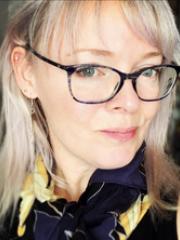Dr Lisa Bode

Researcher biography
Dr. Lisa Bode uses cinema as a starting point from which to explore broader topics in the digital world by researching the evolution of computer generated imagery and its impact on online visual culture. She examines these phenomena through the broader framework of ‘visual effects’ - forms of illusionistic practice and viewing that have evolved out of film, optical toys, funfair amusements, and magic shows, with roots in art and science.
Bode argues that in the age of digital image manipulation, like that found on various social media platforms, visual effects have infiltrated contemporary visuality. At their most spectacular, visual effects power our blockbuster movies, TV, and video games, constructing fantastical story-worlds; while at their least visible, they erase distracting elements of sets, costume, and performance. At their most quotidian, they live on smartphones, allowing users to augment selfies with rabbit ears or zombie masks, smooth laugh lines, and insert one's' face into music or movie videos. It is here that these uses of visual effects can enter their most troubling, creating deceptive illusions, and challenging viewers to question reality in their visual mediation of the world and each other.
In June 2018 Bode gave the weekly research seminar on her work-in-progress historicizing the digital human face in cinema. The talk was titled “Masks, Simulations, and Elusive Sparks: Four Decades of the Digital Human Face in Cinema”.
Bode’s monograph Deepfakes and Digital Bodies for Rutgers University Press (2022) and co-edited issue of Convergence: International Journal of Research into New Media Technologies (Bode, Golding, Lees) aim to deepen understanding of the historical evolution and cultural implications of visual effects in perception and evaluation of human bodies. She is also developing the concept of “platform VFX” as a way of thinking about 1) new forms of illusionistic content that are made specifically for video sharing platforms such as YouTube, and that is emerging from a confluence of larger technological, industrial, and cultural transformations; and 2) the ways in which the affordances of different media platforms allow for the creation and/or sharing of manipulated media content. As a sub-category of Platform VFX, she is developing the concept of “vernacular VFX” to better understand the emergence of everyday practices of playful illusionism, beautification, identity-play, or deception in augmented selfie and face-swap apps.
At the 2018 Digital Bodies and Devices symposium, Bode spoke on the 1980 Michael Crichton film Looker, and its foreshadowing of later developments in the use of VFX on social media and other platforms.
“The human figure remade visually through a new image technology is received as uncanny within a framework informed by scientific and science fictional discourses on the nature of human life, texts, both theoretical and fictional, concerning the impact of aspects of contemporary life (urbanization, media, consumerism, etc.) on lived experience. This figure becomes uncanny because, for a moment, its mismatching cues of deathliness and liveliness are in synch with historically situated uncertainties. If the past tells us anything, these perceptions of the digital actor as an uncanny figure will not be permanent,” From Shadow Citizens to Teflon Stars: Reception of the Transfiguring Effects of New Moving Image Technologies, 2006.
In 2019, Bode was interviewed for Little White Lies magazine for the article “Rest in peace and in profit: Is the CGI resurrection trend here to stay?”, following the news that iconic movie star James Dean was to be digitally resurrected for a new movie role.
In 2020, Bode established the Visual Effects Research Network with Leon Gurevitch from Victoria University of Wellington (New Zealand) as a solution to the fragmented, dispersed, and cross-disciplinary nature of scholarship in visual effects, drawing together academics from screen and industry studies, art history, philosophy, and more. The aim is to build a virtual hub for open access to research and other scholarly thinking on visual effects, and a visible community of scholars, who can debate, share insights, opportunities, and provide mentorship and collaboration.
